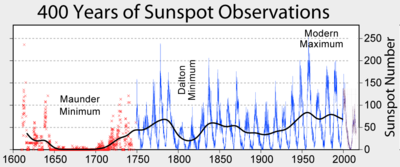If you have ever been in a debate between a global warming skeptic and a global warming catastrophist, you know that sooner or later the issue of the Sun will arise. Skeptics view solar input as likely being the most significant contributor to any climate change that we see, while climate catastrophists view solar input as completely insignificant behind the polluting effects of Mankind. So where does the truth lie?
It’s not an easy question to answer, because climate is so complex that one form of “forcing” (the addition of more heat) in the climate looks very much like the addition of any other form of forcing. So let us start by seeing whether a solar contribution to climate makes any sense at all, and take it where it leads.
We have known that the Sun experiences cycles and “weather” since Galileo Galilei, Thomas Harriot, Johann Goldsmid, and Christopher Schenier discovered sunspots in the West. The Chinese, as always, did it first, and noted the existence of sunspots as far back as 28 BCE. The modern understanding of the sunspot cycle, however, and its varying intensities, is still an area of research. We know that sunspots (or more precisely, solar activity) does affect the environment in which the earth operates. And we know that there have been significant changes in solar activity levels over time — both a 22-year spot cycle, and a longer term, less well understood waxing and waning of that cycle. This latter trend has given us activity minima lasting hundreds of years, such as the well-known Maunder Minimum, where activity essentially stopped. The Maunder Minimum is well correlated with the climactic period on Earth known as the Little Ice Age – a period where canals froze in the winter throughout Europe, and which is thought to have contributed to the demise of the Vikings living on Greenland. Ice core data also definitively shows that the Little Ice Age was not a figment of climate skeptic imagination.

So, anecdotally, there is good reason to suspect a connection between solar activity and climate. But up until recently, there were no plausible theories connecting the two. This may be hard for a skeptic to understand, but without a good causal connection, catastrophists simply could pooh-pooh the data as being nothing more than random correlation.
This all changed recently when some CERN scientists found the widely-sought causal link between solar activity and climate. Specifically, they found that drops in solar activity led to increased formation of clouds — because of cosmic ray seeding.
The catastrophist response has been to point out that this is a small effect, compared to other ways of forming clouds. But, while that may be true, there’s plenty of reason to think that small changes do matter as far as climate is concerned. After all, almost everyone involved in the climate debate agrees that a temperature increase due to more CO2 by itself would be quite small, but that the effect of that increase is amplified by another greenhouse gas: water vapor. Remember, though, that the same amplification will happen for any contribution to warming or cooling from solar activity. Thus, there’s no plausible way to claim that CO2 increases are significant, but solar-activity-induced cloud formation increases are not.
So where does this leave us? It appears that solar activity is highly relevant to earth climate. Both CO2 and solar activity are conceivably of the same order of magnitude, and both inputs, while small, get amplified by water vapor. And no, this does not mean it explains all of recent climate change, nor is it the case that CO2 levels are inconsequential for climate. The true answer is probably neither one extreme nor the other.
Our understanding is likely to improve in short order, though. Recent work developing a dual dynamo model of solar activity predict a fall-off in solar activity comparable to the Maunder Minimum, starting in a decade or so. Computer models that base temperature predictions solely on CO2 concentrations predict accelerating warming. What the actual climate does should allow us to figure out the degree of solar contribution to climate, once and for all.

Active Comment Threads
Most Commented Posts
Universal Background Checks – A Back Door to Universal Registration
COVID Mask Follies
When Everything Is Illegal…
An Anti-Vax Inflection Point?
“Not In My Name”
The Great Social Media Crackup
War Comes Through The Overton Window
The First Rule of Italian Driving
Most Active Commenters